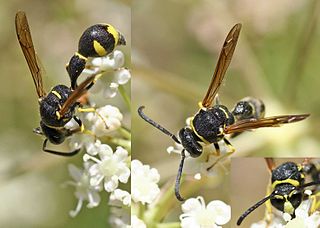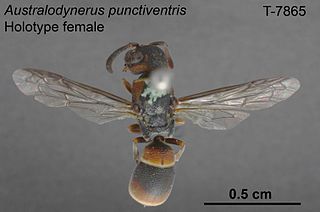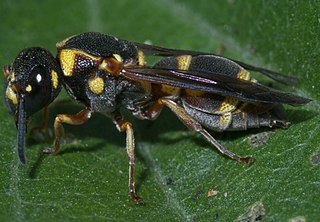
Polistes is a cosmopolitan genus of paper wasps and the only genus in the tribe Polistini. Vernacular names for the genus include umbrella wasps, coined by Walter Ebeling in 1975 to distinguish it from other types of paper wasp, in reference to the form of their nests, and umbrella paper wasps. Polistes is the single largest genus within the family Vespidae, with over 200 recognized species. Their innate preferences for nest-building sites leads them to commonly build nests on human habitation, where they can be very unwelcome; although generally not aggressive, they can be provoked into defending their nests. All species are predatory, and they may consume large numbers of caterpillars, in which respect they are generally considered beneficial.

Eumenes is a genus of wasps in the subfamily Eumeninae. It is a large and widespread genus, with over 100 species and subspecies occurring worldwide. The genus was first proposed by Pierre André Latreille in 1802, with the type species later designated by Latreille in 1810. All species make jug-like nests out of mud, usually attached to twigs. The larvae are fed with caterpillars.

Ancistrocerus is a widely distributed genus of potter wasps present in many biogeographical regions of the world. They are nonpetiolate eumenine wasps with a transverse ridge at the bending summit of the first metasomal tergum and with a low and opaque propodeal lamella completely fused to the submarginal carina.

Australodynerus is an Australasian genus of potter wasps.

Delta is an Old World genus of potter wasps with species predominantly distributed through tropical Africa and Asia. Some species are present in the Palearctic region, and a few have been introduced in the Nearctic and Neotropical regions. The members of this genus have a long metasomal petiole, like members of the genera Eumenes and Zeta.

Ropalidia is a large genus of eusocial paper wasps (Polistinae) in the tribe Ropalidiini distributed throughout the Afrotropical, Indomalayan and Australasian biogeographical regions. The genus Ropalidia is unusual because it contains both independent and swarm-founding species. Ropalidia romandi is one of the swarm founding species, meaning that new nests are founded by a large group of workers with a smaller number of inseminated females, while Ropalidia revolutionalis is independent-founding, meaning that each nest is founded by a single foundress.

Paraleptomenes is a primarily Indomalayan genus of potter wasps. There is a single species, Paraleptomenes miniatus, reported outside of the region, from the island of Mauritius in the Afrotropical region.

Stenodynerus is a rather large genus of potter wasps whose distribution spans the Nearctic, Palearctic, Oriental and Neotropical regions. Most of its species lack a transverse carina on the first metasomal tergum. A pair of medial pits on the anterior face of the pronotum and the expansion of the tegulae put this genus close to genera as Parancistrocerus, Hypancistrocerus and Eustenancistrocerus.
Knemodynerus is a genus of potter wasps distributed through the Palearctic, Afrotropical, Indomalayan and Australasian regions. The species currently classified in the genus are:

Rhynchium is an Australian, Afrotropical, Indomalayan and Palearctic genus of potter wasps.
Eustenancistrocerus is an Afrotropical, Palearctic and Oriental genus of potter wasps. The species in this genus include:

Pareumenes is an Afrotropical, Palearctic and Oriental genus of potter wasps.
Pseudalastor is an Australian genus of potter wasps.
Pseudepipona is a genus of potter wasps found in the Palearctic, Nearctic, Afrotropical and Australian regions.Andrey sus
Zetheumenidion is a small afrotropical genus of potter wasps currently containing 11 species, one of them previously with two subspecies. The species are distributed through southern and eastern Africa.

Pseudonortonia is a fairly large genus of potter wasps with a rich Afrotropical fauna, as well as with several species which occur throughout the Palearctic and Indomalayan regions.
Labus is an Indomalayan genus of potter wasps. It contains the following species:

Phimenes is an Indomalayan and Australasian genus of potter wasps. The genus was formerly regarded as a synonym of Delta. The genus was separated from Eumenes by the Italian hymenopterist Antonio Giordani Soika when he elevated division IV of Eumenes, which Saussure had given the name Phi to, to full generic status. However, Giordani Soika noted that the name Phi was preoccupied by a subgenus of the New World polistine genus Mischocyttarus and he therefore chose to compound Phi with Eumenes into Phimenes as the name for the new taxon.
Pseudagris is an Afrotropical genus of large potter wasps, formerly treated as a subgenus within Synagris.













